ADAS and Autonomous Driving Industry Chain Report, 2018-2019– Automotive Processor and Computing Chip
As automobiles are going smart, cockpit and intelligent driving require more efficient processors.
Full LCD instrument cluster with at least 3 or even 5 to 6 screens, will be an integral of a mainstream electronic cockpit solution which may be integrated with some local and cloud capabilities such as natural language processing (NLP), gesture control, fatigue detection, face recognition, AR HUD, HD map and V2X. So it can be said that cockpit has endless demand for computational resources, for instance, 50000DMIPS in 2020 and more after the year.
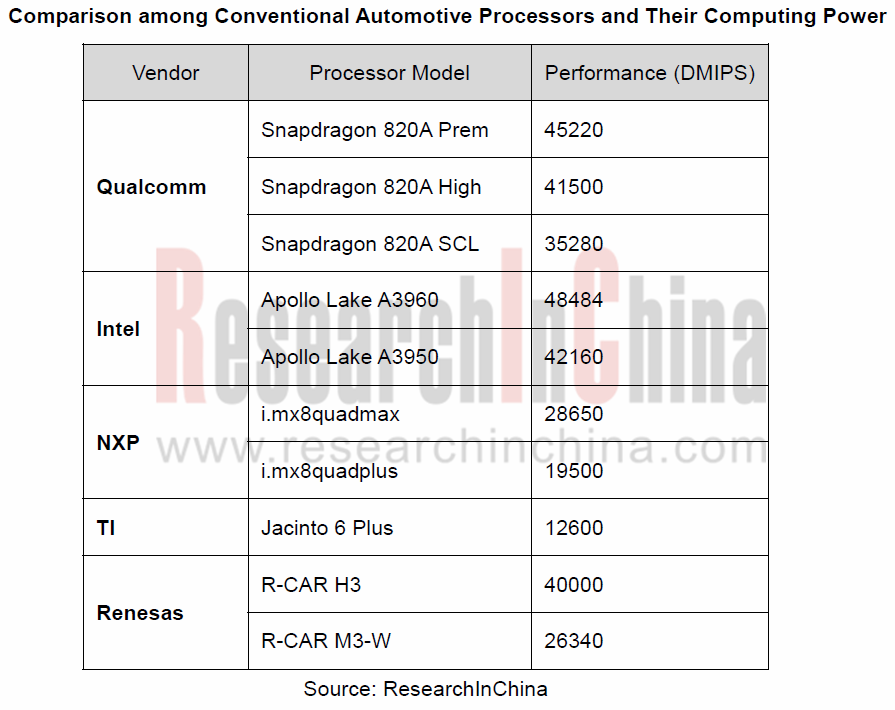
Autonomous driving needs processors that perform far better. According to Horizon Robotics’ summary of OEM demand, a higher level of automated driving means more orders of magnitude, namely, 2 TOPS for L2 autonomy, 24 TOPS for L3, 320 TOPS for L4 and 4,000+TOPS for L5.
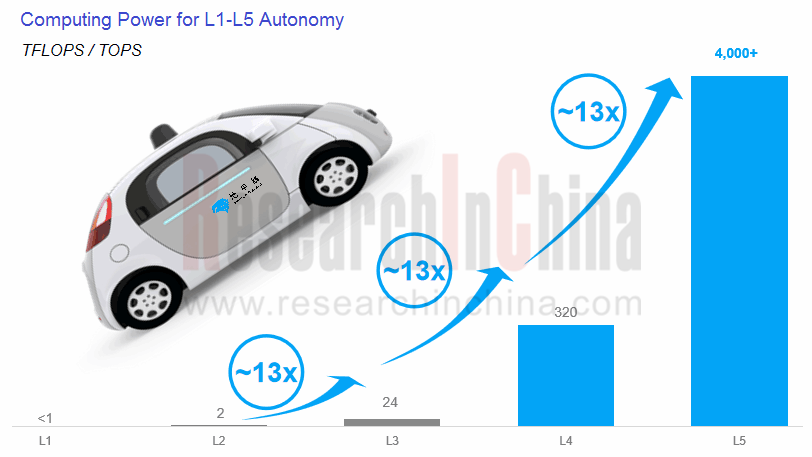
Source: Horizon Robotics
Only computing power is not enough. Complexity of automotive applications should be taken into account. That’s because an automotive processor also has to consider how much power is consumed, how much computing power is used or whether it is up to the automotive and safety standards or not.
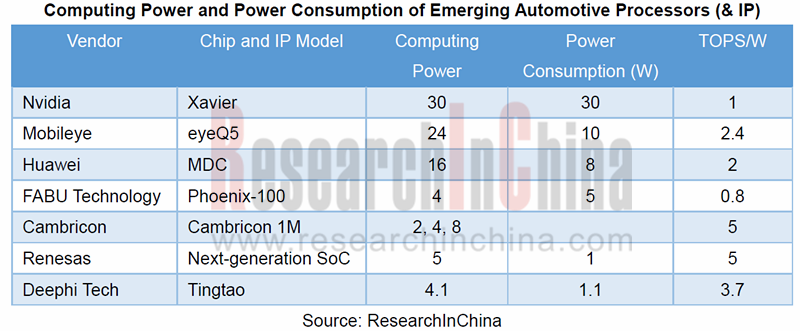
Automotive processor, also referred to as automotive computing chip, typically falls into three types: Application specific standard products (ASSP), like CPU and GPU; application specific integrated circuits (ASIC); field programmable gate arrays (FPGA). Conventional CPU and GPU have begun to find it hard to meet increasing new demand as AI computing is developing by leaps and bounds, and in terms of energy efficiency, underperform semi-custom FPGA and full-custom ASIC, both of which are booming.
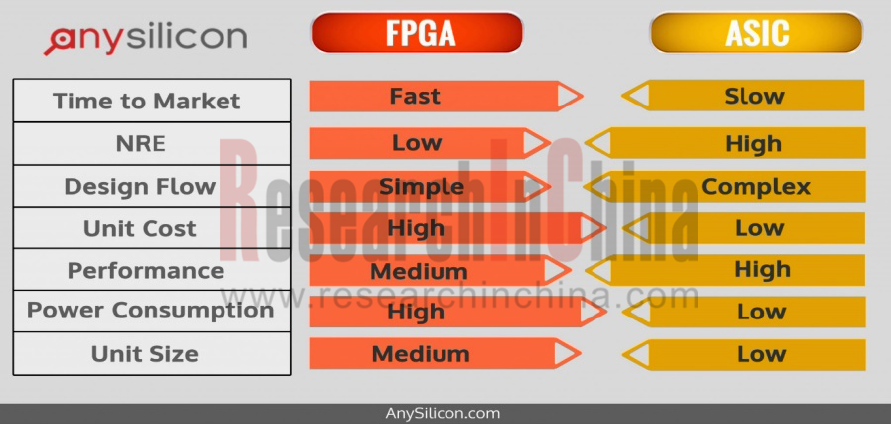
By and large, FPGA and FPGA have their own merits and demerits, offering options for different areas
The huge demand from intelligent connected vehicle (ICV) for semiconductors (including processors) is an enticement for the inrush of consumer electronics processor vendors. Take example for Qualcomm, the fastest entrant whose 820E and 855E among other products have won great popularity in automotive sector. Of the top 25 OEMs worldwide, 18 have chosen the giant’s processors. Samsung, MediaTek, Huawei and even Apple follow suit to forge into the automotive semiconductor field.
Processor vendors’ fight is more than in computing power area. Tool chain is also their battleground.
One competitive edge on processor lies in more tools for users’ easier and more efficient use of processors.
“No one will buy your GPU, if you don’t have software and applications”, said Greg Estes, the vice president of NVIDIA, at GTC CHINA 2018. With efforts, the inventor of the GPU has expanded its developer’s community with more than 1 million members and 600,000 GPU applications.
In 2017, NVIDIA unveiled new NVIDIA? TensorRT? 3 AI inference software that significantly boosts the performance and slashes the cost of inferencing from the cloud to edge devices, including self-driving cars and robots. With TensorRT, the user can get up to 40x faster inference performance comparing Tesla V100 to CPU. TensorRT inference with TensorFlow models running on a Volta GPU is up to 18x faster under a 7ms real-time latency requirement.
At CES 2019, NVIDIA didn’t release more efficient processors but enlarge its software tool kit. The company integrated its previous Drive Autopilot software, Drive AGX computing platform and DRIVE Works development tool into a platform, called Drive AP2X. DRIVE AutoPilot offers precise localization to the world’s HD maps for vehicle positioning on the road and creates a self-driving route. Drive Works provides developers with reference applications, tools and a complete module library.
Deephi Tech’s deep neural network development kit (DNNDK) is an equivalent of NVIDIA TensorRT. DNNDK offers a complete process from neural network inference to model compression, heterogeneous programming, compilation and operation deployment, which is a solution for deep learning algorithm engineers and software development engineers to accelerate AI computing load.
In July 2018, Xilinx acquired Deephi Tech in a USD300 million deal, helping the two-year-old firm promote FPGA.
Starting from EyeQ?5, Mobileye will support an automotive-grade standard operating system and provide a complete software development kit (SDK) to allow customers to differentiate their solutions by deploying their algorithms on EyeQ?5. The SDK may also be used for prototyping and deployment of Neural Networks, and for access to Mobileye pre-trained network layers.
In July 2018, Intel released OpenVINOTM Toolkit for accelerating development of high performance computer vision and deep learning vision application.
There are more than 70 AI start-ups globally, but few of them remain powerful enough to develop tool chain. And conforming to the active safety standards poses a bigger challenge to development of automotive computing chip tool chain.
In China, Horizon Robotics, an autonomous driving chip bellwether, provides full-stack perception software and full-stack tool chain. The way of coordinating algorithms, computing architecture and tool chain enables the firm’s BPU with a performance 30 times higher than GPU.
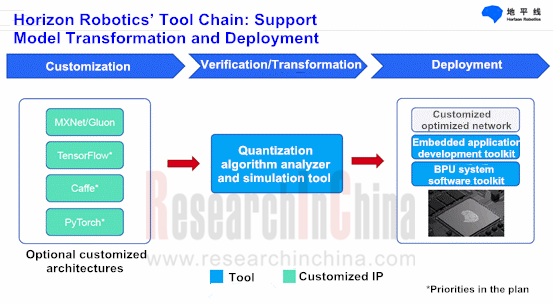
Automakers are deficient in deep learning capability of their processors as well, and they are going all out to improve weaknesses.
In early 2019, NXP joined forces with Kalray to co-develop an autonomous driving computing platform, with the aim of helping NXP gain muscle in deep learning. The partnership will combine NXP’s scalable portfolio of functional safety products for ADAS and Central Compute with Kalray’s high-performance intelligent MPPA (Massively Parallel Processor Array) processors. MPPA with an optimized tool and a library, enables the best performance of deep learning or vision algorithms.
Renesas plans to roll out next-generation R-CAR SoC for deep learning, which is expected to be mounted on L4 autonomous cars in 2020. The new SoC sample will be unveiled in 2019, and can compute 5 trillion times per second with power consumption of a mere 1W. Also, Renesas upgrades its processor tool chain and ecosystem via its Autonomy Platform.
Two-wheeler Intelligence and Industry Chain Research Report, 2025-2026
Two-Wheeler Electric Vehicle Research: New National Standard Drives Intelligent Popularization, AI Agent Makes Its Way onto Vehicles
ResearchInChina releases the "Two-wheeler Intelligence and Industr...
China Smart Door and Electric Tailgate Market Research Report, 2025
Smart Door Research: Driven by Automatic Doors, Knock-Knock Door Opening, etc., the Market Will Be Worth Over RMB100 Billion in 2030.
This report analyzes and researches the installation, market size...
New Energy Vehicle Thermal Management System Industry Research Report, 2025-2026
Policy and Regulation Drive: Promoting the Development of Electric Vehicle Thermal Management Systems towards Environmental Compliance, Active Safety Protection, and Thermal Runaway Management
Accord...
Intelligent Vehicle Redundant Architecture Design and ADAS Redundancy Strategy Research Report, 2025-2026
Research on Redundant Systems: Septuple Redundancy Architecture Empowers High-Level Intelligent Driving, and New Products Such as Corner Modules and Collision Unlock Modules Will Be Equipped on Vehicl...
Passenger Car Mobile Phone Wireless Charging Research Report, 2025
Automotive Wireless Charging Research: Domestic Installation Rate Will Exceed 50%, and Overseas Demand Emerges as Second Growth Driver.
The Passenger Car Mobile Phone Wireless Charging Research Repor...
Automotive 4D Radar Industry Research Report 2025
4D radar research: From "optional" to "essential," 4D radar's share will exceed 50% by 2030.
1. 4D imaging radar has transformed from an "optional" to a "must-have" sensor.
4D radar adds the detecti...
China Automotive Multimodal Interaction Development Research Report, 2025
Research on Automotive Multimodal Interaction: The Interaction Evolution of L1~L4 Cockpits
ResearchInChina has released the "China Automotive Multimodal Interaction Development Research Report, 2025"...
Automotive Vision Industry Report, 2025
Automotive Vision Research: Average Camera Installation per Vehicle Reaches 5.2 Units, and Front-View Tricam Installation Exceeds 1.2 Million Sets.
From January to September 2025, the total installa...
Automotive Infrared Night Vision System Research Report, 2025
Automotive night vision research: The rise of infrared AEB, with automotive infrared night vision experiencing a 384.7% year-on-year increase from January to September.
From January to September 2025...
New Energy Vehicle Cross-Domain (Electric Drive System and Powertrain Domain) Integration Trend Report 2025-2026
Electric Drive and Powertrain Domain Research: New technologies such as three-motor four-wheel drive, drive-brake integration, and corner modules are being rapidly installed in vehicles.
Electric dri...
Analysis on Desay SV and Joyson Electronic's Electrification, Connectivity, Intelligence and Sharing, 2025
Research on Desay SV and Joyson Electronic: Who is the No.1 Intelligent Supplier?
Both Desay SV and Joyson Electronic are leading domestic suppliers in automotive intelligence. "Analysis on Desay SV ...
OEMs and Tier 1 Suppliers' Cost Reduction and Efficiency Enhancement Strategy Analysis Report, 2025
ResearchInChina released the "OEMs and Tier 1 Suppliers' Cost Reduction and Efficiency Enhancement Strategy Analysis Report, 2025", summarizing hundreds of cost reduction strategies to provide referen...
Automotive Fixed Panoramic Sunroof and Smart Roof Research Report, 2025
With the intelligent application of car roofs as the core, this report systematically sorts out a series of new products such as fixed panoramic sunroof/openable sunroof, ceiling screen, roof ambient ...
Automotive-Grade Power Semiconductor and Module (SiC, GaN) Industry Research Report, 2025
SiC/GaN Research: Sales volume of 800V+ architecture-based vehicles will increase more than 10 times, and hybrid carbon (SiC+IGBT) power modules are rapidly being deployed in vehicles.
Sales volume o...
Cockpit Agent Engineering Research Report, 2025
Cockpit Agent Engineering Research: Breakthrough from Digital AI to Physical AI
Cockpit Agent Engineering Research Report, 2025 starts with the status quo of cockpit agents, summarizes the technical ...
Prospective Study on L3 Intelligent Driving Technology of OEMs and Tier 1 Suppliers, 2025
L3 Research: The Window of Opportunity Has Arrived - Eight Trends in L3 Layout of OEMs and Tier 1 Suppliers
Through in-depth research on 15 OEMs (including 8 Chinese and 7 foreign OEMs) and 9 Tier 1 ...
China Commercial Vehicle IoV and Intelligent Cockpit Industry Research Report 2025
Commercial Vehicle IoV and Cockpit Research: The Third Wave of Passenger Car/Commercial Vehicle Technology Integration Arrives, and T-Box Integrates e-Call and 15.6-inch for Vehicles
I. The third wav...
Intelligent Vehicle Electronic and Electrical Architecture (EEA) and Technology Supply Chain Construction Strategy Research Report, 2025
E/E Architecture Research: 24 OEMs Deploy Innovative Products from Platform Architectures to Technical Selling Points
According to statistics from ResearchInChina, 802,000 passenger cars with domain...